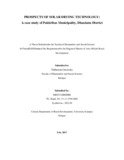Please use this identifier to cite or link to this item:
https://elibrary.tucl.edu.np/handle/123456789/2171| Title: | Prospects of Solar Drying Technology: A Case Study of Pakhribas Municipality, Dhankuta District |
| Authors: | Ghimire, Kriti |
| Keywords: | Solar Drying;Technology;Pakhribas Municipality;Dhankuta District |
| Issue Date: | Feb-2017 |
| Publisher: | Central Department of Rural Development, University Campus Kiripur |
| Abstract: | Open sun drying of various crops is the most widespread conventional method for food preservation practiced in many urban and rural areas of developing countries. The traditional open sun-drying widely practiced by rural farmers has some sort of difficulties such as; high crop losses due to inadequate drying, fungi attacks, insects, birds, rodent encroachment and unpredictable weather effects Labor requirement, long drying time, and direct exposure of the produce to sun and wind are the further difficulties with this method. However, taking into account the low income of the rural population, the relatively high investment for energy based dryers still remains a barrier to wide application. In view of this, solar dryers can be a good alternative over conventional dryers and open sun drying technique. General objective of the study is to identify the prospects of solar drying technology with the case study of Pakhribas Municipality of Dhankuta district. The study explored the prospects of solar drying, using descriptive research strategy because it aims to study the prospects of soar dryer in underscoring rural enterprises. It looked into the problem by exploring the views of different set of respondents, as well as by exploring different literatures related with the study. Vegetables especially off season, tea, large cardamom and ginger are major source of income for the eastern hill people. Farmers try to sell all the produces at once as they may go rotten, being perishable produces. In this effort they sell them even in lesser prices. This down price occurs when the overall production is high. They do not know about the drying technologies like solar drying. And even do not know about the subsidy they can receive. Most of the agricultural products are exported to the neighboring countries. Some agricultural products like Tea, coffee, spices are also exported to the countries of Europe. Because of the small size of export, the bargaining power of Nepali exporters is limited and weak. One of the benefits of Solar Dryer system compare to the sun drying is quick dehydration. It is estimated about 50 to 60 percent of the time is saved in solar dehydration compared to direct sun drying. Besides this, with the installation of Solar Dryer, women got some relief. They can dry the products easily. Several sun dried products eg., dried herbs, dried ginger, dried turmeric, dried cinnamon, dried vegetable seeds and tea are exported to India. Some vegetable seeds are also exported to Bangladesh and Pakistan. Therefore the dried products have huge possibility of receiving internal and external market. The temperatures in a solar dryer are higher than in sun drying and this reduces the drying time and usually improves the final product quality. Crop losses and spoilage from rain and animals are prevented because the crop is protected within the solar dryer. Solar dryer comprises three parts; in some types of drier these parts are distinct whereas in other these parts are in combined form. The introduction of low cost and locally manufactured solar dryers can offer a promising alternative to reduce the tremendous postharvest losses as small farmers mostly use open sun drying methods for drying of certain produces. Thus along with promotional activities of Solar dryer through subsidy, technical backstopping and massive consumer awareness raising program is necessary to create market for the dried products. The technical improvement is also necessary; the Capacity of the drier needs to be increased and should be affordable to the farmers. |
| URI: | http://elibrary.tucl.edu.np/handle/123456789/2171 |
| Appears in Collections: | Rural Development |
Files in This Item:
| File | Description | Size | Format | |
|---|---|---|---|---|
| 12813rd.pdf | 1.19 MB | Adobe PDF |  View/Open |
Items in DSpace are protected by copyright, with all rights reserved, unless otherwise indicated.
